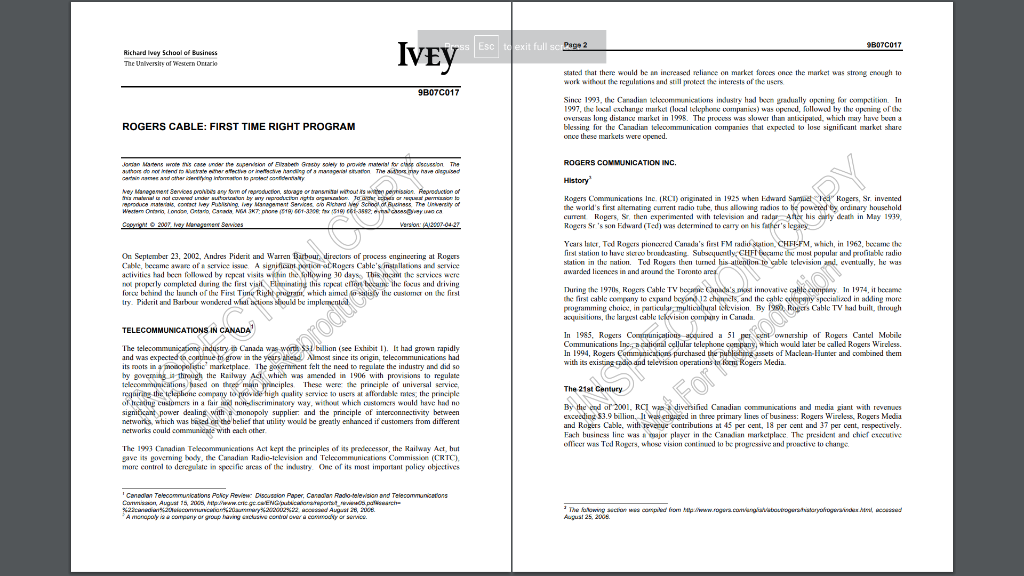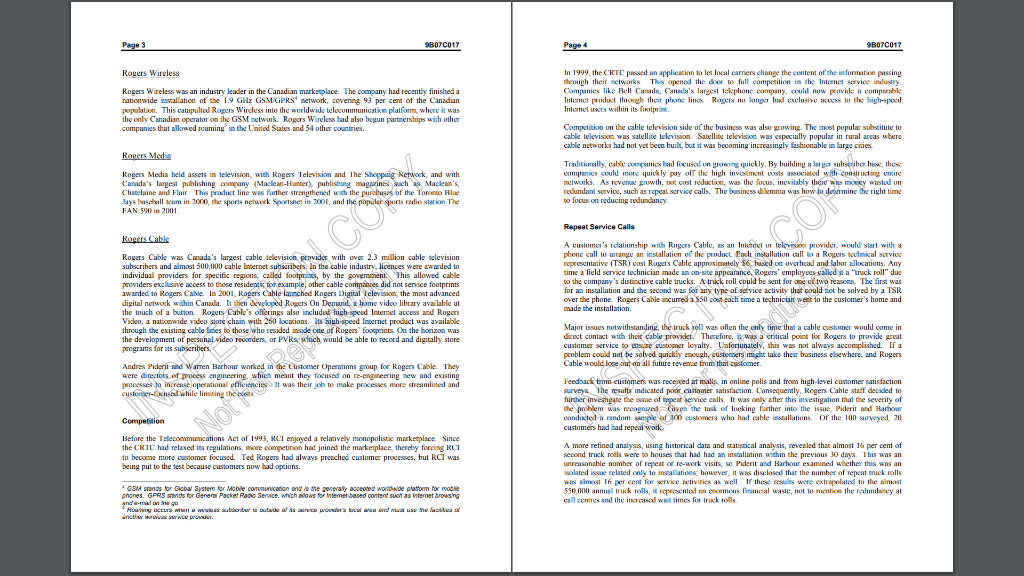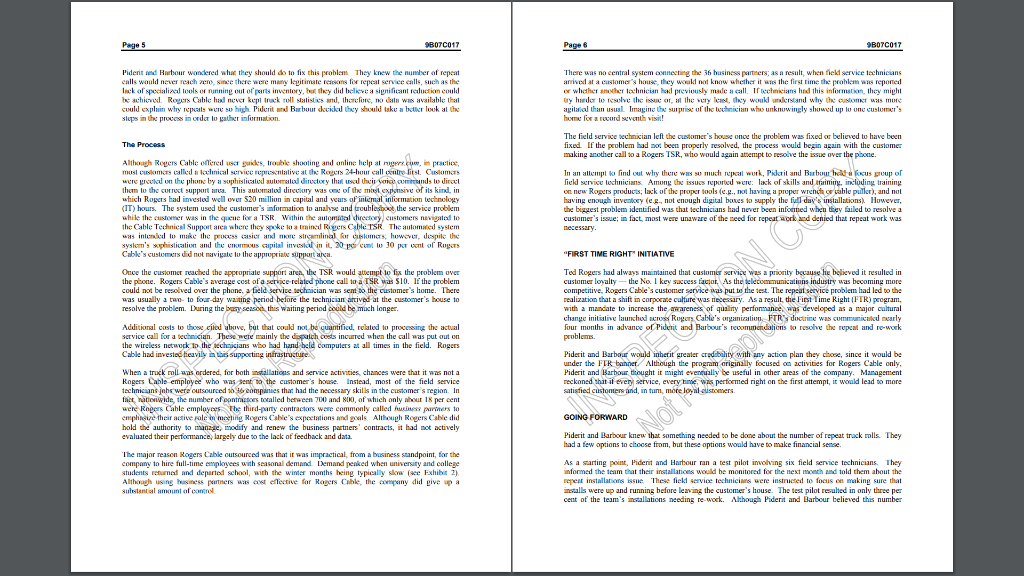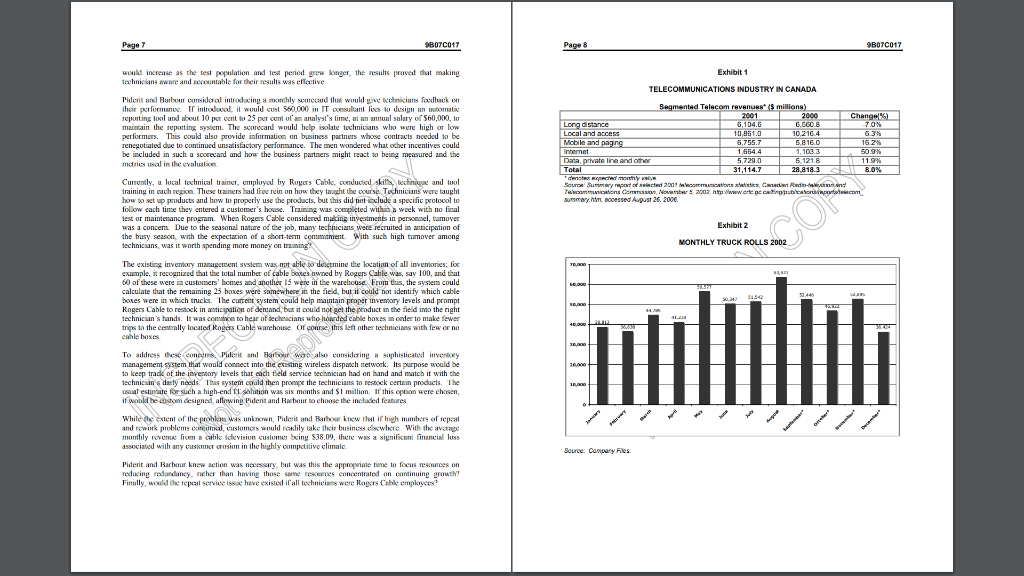Answered step by step
Verified Expert Solution
Question
1 Approved Answer
Do the following on 2 pages, double-spaced (500 words). Analyze the case study and, then, answer the following case questions. 1. Why did this problem




Do the following on 2 pages, double-spaced (500 words). Analyze the case study and, then, answer the following case questions.
1. Why did this problem go unnoticed for so long?
2. Analyze RCI's current competitive situation.
3. Lay out the service activity process, including the costs at each step, for an unresolved installation.
4. What should Piderti and Barbour do? How should they implement their action plans? What will it cost?
Richard lvoy 5 chool of Businuss The Unilversit? of Fextern Deriarlo 99007C017 stated that there would be an increased relianee on murket faress onee the market was strong enocegh to work wirhas the regulations and snill procect the interests of the users Sinc: 1993, the Carsdinn welocommunications industry has been gudually upening far tampetition. In verseas long disdance market in 1998 . The process was skue than anticipaide, which may have bem a ROGERS CABLE: FIRST TIME RIGHT PROGRAM bicssing for the Cansdian ickeoommunication companies that expeciad to lose signifitant market share once these marsets were opened. Page 3 Page 4 9B07C017 Rogers Wireless In 1999, the CRTC pasead an applicacion to let local camers change the content of the information passing therugh their netwarks. This opened the deer to full eompetition in the lntemet servies induscry. Rogers Wireless was an industry leader in the Canadian markerplace. The coempany had recently finished a Companica like Rell Caratli, Canala's largest tekphone expany, ovuld now provide a compendik nationwide installation of the 1.9GHz GSM/GPR.S4 network, covering 93 per cent of the Canadian Intemet poduct thregh their phone lines. Rogers no langet haxl esclugive acuss to the high-spozd popalation. This calapullud Rogers Wircless inte the werldwids blocummunication platfonm, where in was lriternel users within its foolprint. the coly Cansdian operatur on the GSM network. Rogers Wirelss had also bepun partnerships with other companies that allowed roaming in the Uinitad States and 54 other courtries. Competition on the cable television side of the busincss was also growing. The most popular subetitute to cable television was satellite television. Satellite television was especially popular in rural arcas where cable networks had not yet becn built, but it was becoming intrasingly festionable in large critie. Rapers Media Traditianally, cable conmeanics lad ficusol on goning quickly. By building a lager sulseciber base, thes: Kogers Media held assets in television, with Rogers Television and The Shopping Network, and with comparics could mus quitkly pay of the high investmknt wosls assucialded with-enslfuting entire Comada's largest publishing coumpany (Maclean-Huner) publishing magprines zach as Mackean's, networks. As rovenas growith, not cosl reduction, was the focus, inevilably thene mas mucy waslad on Chaselaine and Flair This produst line was further strengthened with the purstases of the Torono Blac redundamt strvioe, such as repeat service calls. The besiness dikemma was how in determine the right time Jays baselall ienm in 2000 , the spors netuork Spertsnet in 2001 , and the populer qoorts rudie starion The FAN 590 in 2001. Kogers. Cable to focus on reducing redundancy. Repeet Service Calla A cuslumer's tdationship with Regers. Cable, as an Interel or bherison provider, would start with a Rogers Cable was Canada's largest cable tclevision provider with over 2.3 million cable television phone call to arrange an installation of the product Fach inetallation tall to a Rogers bethical sarvior subseribers and almost 500,000 cable lnsernet subseriber. In the cable industry, licences were awarded to individual providers for specific regions, called footprins, by the govemenem. This allowed cable providers exclusive sccess to those residents; for example, other cable compones did not service footprints time a field service technician made an on-site apperarnce. Rogers' employees selkd vil a "truck roll" due awarded to Rogers Cable, In 2001, Kogers Cable latnehed Kogers Digital Yelevision, the mast advanoed. 60 the company's distiective cable trucks. A truck roll could be sent for cme of two reasoes. The first was for a installation and the second was for any type of service activity that could not be solved by a TSR digital network within Candia. [t then developed Rogers On Demand, thome vidoo library available at the touch of a bution. Rogers Cable's ofterings also included highesped Interset access and Rogers Video, a nationwide video store chain with 260 locations. Its thighispeed Internat product was available over the phone. Rogers Cable incuresa a 550 coet each time a technician went to the customer's home and made the installation. through the existing cablefines to those "qho resided inside che of Rogers" foocpcints. On the hocizon was the development of personal video recorders, or PVRs phtich wald be able to record and digitally store programs for its subgeribers. Major issues notwithstanding, the truck roll was often the enly time that a cable cuskomer would come in direct contact with their cable protidet. Therefore, A.mas e eritital point for Rogers to provide grat customer service to ensere customer loyalty. Unforlunately, this was not always accomplished. If a Andres Piderit wed Warren Barbour worked in the Costomer Operations group for Kogers Cable. They problem could nat be solved quickly enough, custoesers mught take their business elewhere, and Rogers were dinectors of peopers engineering, which meant they focused on re-emgineering new and existing proesses to incrente eperational efficiefciss it was their job to make proceses more streamlined and cusfepter-6anent while limiring the pred Fedoacf from enstomers was reoejed af itulls, in online polls and from high-level customer satisfaction surveys the resalts indicated poor enstomer satisfaction. Consequently, Rogers Cable staff decided to furrther (investigate the isoe of ropeat serviee calls. It was celly after this investigation that the severity of the pooblem was recognized Civen the task of loeking further into the is5ue. Piderit and Harbcur Compebtion eondicted a random sampe of 100 ciscmers who had eable installations. Of the 100 surveyed, 20 customers had had repeat wodk, Before the Ielecommunications Act of 1995,RCl enjoyed a relatively monopolistic marketplace. Since the CRIC had relaxed its regulations, more oxmpetion had joined the maketplace, therely forcing RCI to becoene more ousiomer focused. Ted Rogers had always presched customer processes, but RCl was being put to the test because customers now had options. A more refined analysis, using historical data and statistical analysis, revealed thas almost 16 per cent of second truck rolls were to houses that had had an instollation within the previous 30 days. This was an unreasonable number of repeat or re-uxrk visits, so Piderit and Bartour examined whether this was an eoolated issece relared cally to installations, however, it whes diselased thar the number of repeat truck rolls wie slmast 16 per eent for service netivities as well. If these resulitg were extripelated to the ailmost phones. GPPS cthes for Generw Pschet Rado Sevice, which alowe for intemet bosed contert such ss hremet terushg 550000 annual truck rolls, it repesented fin eroemeus firaneial waste, not to mention the relundicce at ande-tmal ai an ga call cemines and the inceasel whit limes fis ln k k wils. would increase as the test pepulation and test period gren bonger, the results proved that making Exhibit 1 tcehnicians awane and feovuntable for their results was effretive TELECOMMUNICATIONS INDUSTRY IN CANADA Pideril and Barbour corrsidacd introdacing a momthly sorecand tha wouk giv fethicians foedtack on reporting lool and about 10 per ocnt lo 25 per cemt of an analyst's time, at an annual salary of 560,000, to mainain the reporting system. The scoresard would halp isolate tochnicisas who were high or low performers. This could also provide information on busincss partners whose contrats needed to be renegotiated due to continued unsatisfictory performance. The men wondered what oher incentives could be included in such a socrecard and how the business partners might reast to being measured and the metries wsed in the evalustion. training in each region. These trainers had free rein on how they tavaht the course. Tuchnicians were taught how to set up products and how to properly use the products, but this did not ieclude a specific protocol to follow each time they entered a customer's house. Training was completed with a week with no fieal test or maintenance program. Whea Rogers Cable considered making invertments in persoesel, tamover was a concem. Due to the seasonal nature of the job, many technicians were recruited in articipation of the busy sezson, with the expectarion of a sbort-term commitment. With such high tumover among technicians, was it worth spending more money on trzining? "Aenstes expected montry wali: cummay.hts, ocoessed August 26.2006. The existing invenbory maragement sysiem was not able bo dedctmine the location of all invemories; for example, it recognized that the total number of cable bones awned by Rogers Cahle was, say 100, and that 60 of these were in customers' homes and another 15 were in the warehouse. From this, the sysiem could. calculate that the remaining 25 boves were samentere in the field, but it coald not identify which cable boxes were in which trucks. The cutent system could help maintain proper invenory levels and prompt Rogers Cable to ressick in anticipation of demand, bur it could not get the product in the field into the right technician's hands. It was commone to hear of dechricians who howeded cable boxes in onder to make tewer trijes to the cencrally located Kogers Cable warehouse. Of conre, this left other technicims with few or no cable boxes To address thes coneyms. Pyalerit and Baroyg wase alwe considering a sophisticated inventcey management system that would coenest into the existing wireless dispaxch network. Its purpose would be to keep trade of the inversory levels that each field service technician had on hand and match it with the techniciins daty noeds. This system could then proenge the technicians to restock certain products. The beat estintate fer such a high-end CL solition was six months and $1 million. If this epoion were choeen, if wonkt he elstgem designed, allowing Pident and Babour to choose the inchaded features Whice the extent of the peoblateyas unknonn, Piderit and Batber knew that if high numbers of repeat and rowuk poblems extyimiad, cuslemens avuld readily lake their business chewhete. With the avcrige menthly rovemax fioen a cable Idlivision cuslomer bcing $38.09, thene was a signilicam financial less asseciabed with any cuskomet cusion in the highly vompctitive climale. Exhibit 2 MONTHLY TRUCK ROLLS 2002 Pident and Barbour knew action was necessary, lat was this the approperine time to fecus resouress on reducing malimalancy, rathe than having those same reserpes concentrated on continuing growth? Finally, would the repeat serviee issac hive exised if all technicins were Rogers Cibke employereStep by Step Solution
There are 3 Steps involved in it
Step: 1

Get Instant Access to Expert-Tailored Solutions
See step-by-step solutions with expert insights and AI powered tools for academic success
Step: 2

Step: 3

Ace Your Homework with AI
Get the answers you need in no time with our AI-driven, step-by-step assistance
Get Started


